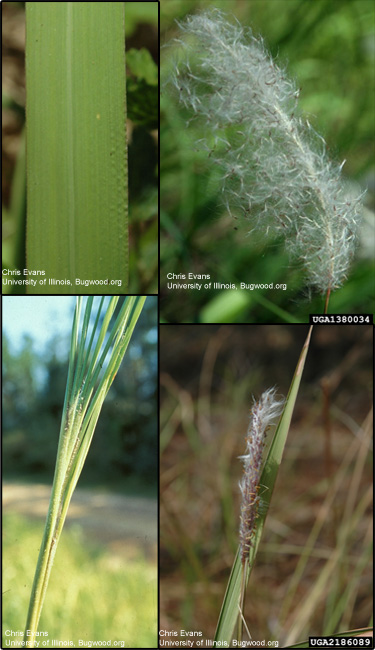Cogongrass (Imperata cylindrica)
 Description: Considered one of the top 10 worst weeds in the world.
Description: Considered one of the top 10 worst weeds in the world.Habit: Perennial, colony-forming grass with whitish, branched, scaly and sharp rhizomes.
Leaves: Sheaths are short, glabrous or pubescent; blades are erect, narrow and pubescent at base; flat and glabrous above, 4 ft. long to less than 1 in. wide; whitish off-centered midvein; margins are scabrous and blade tips are sharp.
Stems: 3-10 feet long, spreading.
Flowers: Plume-like, silky panicle, up to 8 inches long and 1.4 inches wide; several per branch, base circled with long hairs.
Fruit and seeds: 0.14-0.17 in. long.
Habitat: Native to southeast Asia, the Philippines, China and Japan. Can be found in degraded forests, grasslands, arable land, and young plantations.
Reproduction: Reproduces vegetatively and by seed.
Similar species: Brazilian satintail (Imperata brasiliensis).
Monitoring and rapid response: Prescribed burning is not recommended, it is very resistant to heat and can trigger flowering and seed production. Rhizomes must be completely removed to prevent regrowth. Herbicides have shown varying success rates - Prometon, tebuthiuron and imazapyr being most successful. Credits: The information provided in this factsheet was gathered from the University of Florida Center for Aquatic and Invasive Plants and the Global Invasive Species Database.
Individual species images that appear with a number in a black box are courtesy of the Bugwood.org network (http://www.invasive.org). Individual photo author credits may not be included due to the small display size of the images and subsequent difficulty of reading the provided text. All other images appear courtesy of Google (http://images.google.com).
